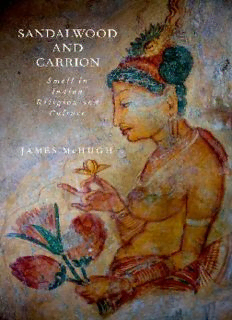
Sandalwood and Carrion: Smell in Indian Religion and Culture PDF
Preview Sandalwood and Carrion: Smell in Indian Religion and Culture
Sandalwood and Carrion This page intentionally left blank Sandalwood and Carrion Smell in Indian Religion and Culture JAMES M c HUGH 1 Oxford University Press is a department of the University of Oxford. It furthers the University’s objective of excellence in research, scholarship, and education by publishing worldwide. Oxford New York Auckland Cape Town Dar es Salaam Hong Kong Karachi Kuala Lumpur Madrid Melbourne Mexico City Nairobi New Delhi Shanghai Taipei Toronto With offi ces in Argentina Austria Brazil Chile Czech Republic France Greece Guatemala Hungary Italy Japan Poland Portugal Singapore South Korea Switzerland Th ailand Turkey Ukraine Vietnam Oxford is a registered trade mark of Oxford University Press in the UK and certain other countries. Published in the United States of America by Oxford University Press 198 Madison Avenue, New York, NY 10016 © Oxford University Press 2012 All rights reserved. No part of this publication may be reproduced, stored in a retrieval system, or transmitted, in any form or by any means, without the prior permission in writing of Oxford University Press, or as expressly permitted by law, by license, or under terms agreed with the appropriate reproduction rights organization. Inquiries concerning reproduction outside the scope of the above should be sent to the Rights Department, Oxford University Press, at the address above. You must not circulate this work in any other form and you must impose this same condition on any acquirer. Library of Congress Cataloging-in-Publication Data McHugh, James. Sandalwood and carrion : smell in Indian religion and culture / James McHugh. p. cm. Includes bibliographical references (p. ). ISBN 978-0-19-991630-6 (hardcover : alk. paper)—ISBN 978-0-19-991632-0 (pbk. : alk. paper)— ISBN 978-0-19-991631-3 (ebook) 1. India—Religion. 2. Rites and ceremonies—India. 3. Smell—Religious aspects. 4. Smell. 5. Odors—India. I. Title. BL2015.R48M34 2013 152.1′660954—dc23 2012003121 1 3 5 7 9 8 6 4 2 Printed in the United States of America on acid-free paper To my parents This page intentionally left blank CONTENTS Preface ix Acknowledgments xvii PART ONE SMELLS IN THEORY 1. Introduction 3 2. Earth, Wind, Foul and Fragrant: Th e Th eory of Smelling and Odors in Early South Asia 20 PART TWO SMELLS IN THE WORLD 3. Lotus, Fish, and Cows: Th e Smellscape of Traditional South Asia 61 4. Flowers and Fish in the M ahābhārata 91 PART THREE SMELLS IN PRACTICE 5. Moon Juice and Uproar: Perfumery Texts 105 6. Allies, Enemies, and Y aks.a Mud: Perfumes 135 PART FOUR AROMATIC MATERIALS 7. Th e Incense Trees of the Land of Emeralds: Exotic Aromatics in Medieval South Asia 159 8. Sandalwood: Merchants, Expertise, and Profi t 180 viii Contents PART FIVE SMELL AND RELIGION 9. Bois des Îles 203 10. Th e Toilette of the Gods 218 Epilogue 244 Appendix : Sanskrit and Prakrit Texts on Perfume Blending and Perfumery 249 Notes 253 Bibliography 2 95 Index 3 13 PREFACE Th is book is about smells, perfumes, and stinks. Of course, smelling requires people (or animals, or, indeed, gods) to do the smelling and also odorous objects such as fl owers, corpses, or elephants to smell. Cambridge Massachusetts, where I started work on this book as a dissertation, smells rather dull for the most part: produce is sold chilled and wrapped; feces and urine are whisked away into sealed sewers; the people of Cambridge (generally) deodorize their bodies and wear little if any fragrance; and on Valentine’s Day, the roses have no scent. In premodern South Asia, as in premodern Europe and North America, the situation was quite diff erent. People, rich and poor, lived in a world that was more varied and pungent in terms of smell: cows roamed the streets; incense burned in homes and temples; gardens were planted with fragrant fl owers; bodies were adorned with garlands and scented pastes, and corpses burned on smoky pyres. Not only was the environment more odorous, but also educated people appear to have been far more interested in and articulate about smells than we are. A quick reading of almost any literary text in Sanskrit will reveal a large number of elabo- rate references to perfumes, fl owers, and even stinks; it would appear that the ideal love life involved the complex use of aromatics; many religious texts abound in olfactory imagery, and the rituals devised for honoring both gods and people frequently use diverse fragrant substances. How might one go about studying smells and perfumes for a whole subconti- nent over a period of many centuries if not millennia? As a scholar of texts, I have chosen to work on the written sources that survive and, given the enormous va- riety of sources that deal with smell in one way or another, I have taken an inter- disciplinary approach. Hence, I have used a wide range of Sanskrit texts, and I also draw on the work of scholars of religion, history, material culture, anthropology, and art history. Th is study is also comparative: I compare the Hindu, Buddhist, and Jain religious traditions in respect to matters of smell,1 and in places I com- pare South Asian discourses on smell with notable features of Western discourses about the senses. ix
Description: